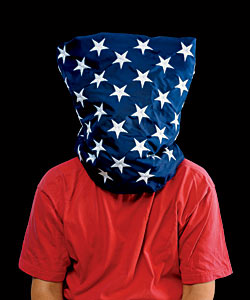
Star Gazing, 2004, Hans Haacke
The instant he saw the photograph, W. J. T. Mitchell knew it would become an icon of our times. Of many pictures leaked from Iraq’s Abu Ghraib prison in 2004, the one that stood out for Mitchell showed a prisoner in a black hood, with wires dangling from his outstretched arms. The pitiful but somehow dignified pose resembled Jesus on the cross.
“As famous as advertising logos and brand icons like the Nike Swoosh or the Golden Arches, the image rapidly mutated into a global icon, that ‘had legs,’ to use the Madison Avenue expression,” Mitchell writes in Cloning Terror: The War of Images, 9/11 to the Present (University of Chicago; $66). The book is one of the first to explore how images have shaped the public’s perception of the war on terror.
The hooded man has inspired interpretations such as Star Gazing (pictured above and in the book), in which the German-born photographer Hans Haacke replaces the hood with a U.S. flag. “The only thing you could possibly see would be the stars on the flag,” says Mitchell, a professor of English and art history at the University of Chicago and a specialist in social and political iconology. “People fool themselves by making themselves seem innocent and oblivious, not wanting to know what’s being done in their name.”
Mitchell explains that images are among terrorists’ most powerful weapons. “The point of terrorism is always to attack the imagination by producing a spectacle and a sense of anxiety, panic, and fear,” he says. But iconic pictures such as the hooded man—and the art that they inspire—can also reveal the truth of our times. “Maybe we’ll finally succeed in pulling that hood off of Haacke’s benighted citizen,” Mitchell says.
Photograph: Hans Haacke/Artists Rights Society


